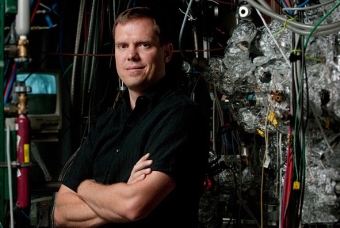
Date:
Location:
Title:
Abstract
The cell’s lipid membrane is one of the most vital cell components as the gate-keeper in and out of the cytoplasm and a critical barrier to integrating technology with biological cells. Newly discovered forms cancer therapy and future biological technologies rely upon manipulating chemical or electronic flow across this membrane. Unfortunately, artificially controlling access through the lipid layer is surprisingly difficult; current techniques often involve harsh chemicals or creating holes that cause cell cytotoxicity. Here we investigate how scaling fluidic technology to the nanoscale can provide non-perturbative access through the cell wall and into biological cells, providing a long-term communication channel for chemical or biological signals. We achieved high-efficiency chemical delivery and control by mimicking natural gap junction proteins, creating arrays of ‘nanostraws’. These nanoscale (100-500 nm) diameter straws are formed by templating high-aspect ratio pores, allowing precise control of height, diameter and thickness. The nanostraws deliver a wide variety of materials that could normally not pass through the cell wall, yet do not disturb natural cell function. Models of how these materials penetrate the lipid bilayer show that a simple impaling mechanism is insufficient, but instead rely upon cellular traction forces to drive membrane rupture.
Surprisingly, we discovered that these nanoscale conduits can not only deliver material into cells, but also can extract minute quantities of cellular proteins and small molecules out. Our data shows that intracellular contents from thousands of cells down to even a single cell can be non-destructively sampled and quantitatively analyzed multiple times over the course of one week, a feat which has not been previously possible. This advance enables new studies of how cells temporally evolve within fully interconnected cell monolayers in response to different therapies and lineage drivers. These, and other similar nanofluidic technologies, open a new area for engineered devices to play a leading role in future biological technologies and healthcare.
Bio
Professor Melosh received his B.S. degree in Chemistry from Harvey Mudd College in 1996, then went on to do a Ph.D. in Materials Science at UC Santa Barbara working with Brad Chmelka, Galen Stucky, and Glenn Fredrickson. He worked with Professor Jim Heath at UCLA/Caltech as a post-doc from 2001-2003, and joined the Materials Science and Engineering department at Stanford University in 2003. Professor Melosh's interests include interfacing inorganic structures with biology, high-temperature energy conversion, and plasmonics. He is a Terman Fellow and Reid and Polly Anderson Faculty Scholar at Stanford University.
Hosted by Brad Chmelka. Light refreshments served. Download event flyer.



